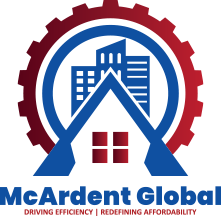Sustainability in architecture is no longer just a trend; it is a necessity for mitigating climate change and reducing environmental impact. Building sustainable structures is not only about being eco-friendly but also about creating efficient, cost-effective, and durable spaces for future generations. Below are key strategies to guide the construction of sustainable buildings:
- Site Selection and Design
Consider the Location:
– Choose a site that minimizes environmental disruption, such as brownfield or previously developed sites.
– Evaluate natural site conditions, such as sunlight, wind patterns, and topography, to optimize building orientation.
Smart Design Practices:
– Design for passive solar heating and cooling by strategically placing windows, shading devices, and thermal mass.
– Use compact building shapes to minimize heat loss or gain.
- Energy Efficiency
Insulation and Glazing:
– Use high-performance insulation materials to reduce heating and cooling demands.
– Install double or triple-glazed windows to improve energy efficiency.
Renewable Energy:
– Incorporate on-site renewable energy systems such as solar panels, wind turbines, or geothermal heat pumps.
– Integrate energy storage systems to enhance reliability and efficiency.
Energy-Efficient Systems:
– Use LED lighting and energy-efficient HVAC (Heating, Ventilation, and Air Conditioning) systems.
– Install energy monitoring systems to track and optimize energy usage.
- Sustainable Materials
Eco-Friendly Choices:
– Use materials with a low environmental impact, such as recycled steel, bamboo, or reclaimed wood.
– Opt for non-toxic, low-VOC (Volatile Organic Compound) paints, adhesives, and finishes to improve indoor air quality.
Local Sourcing:
– Source materials locally to reduce transportation emissions and support regional economies.
- Water Conservation
Efficient Plumbing:
– Install low-flow fixtures and dual-flush toilets to reduce water consumption.
– Incorporate water-efficient appliances, such as ENERGY STAR-certified dishwashers and washing machines.
Rainwater Harvesting:
– Design systems to collect and reuse rainwater for landscaping and non-potable uses.
Greywater Systems:
– Install greywater recycling systems to reuse water from sinks, showers, and washing machines for irrigation or flushing.
- Waste Reduction
During Construction:
– Plan for minimal construction waste by prefabricating components or using modular construction techniques.
– Recycle construction debris, including wood, metal, and concrete.
Operational Waste:
– Provide infrastructure for occupants to separate and recycle waste effectively.
– Encourage composting systems for organic waste.
- Indoor Environmental Quality (IEQ)
Air Quality:
– Ensure proper ventilation systems to improve air circulation and reduce indoor pollutants.
– Avoid materials that emit harmful chemicals, such as formaldehyde or asbestos.
Natural Light:
– Maximize daylighting through large windows, skylights, and light shelves to enhance well-being and reduce artificial lighting needs.
Thermal Comfort:
– Design for consistent indoor temperatures using advanced climate control systems.
- Smart Technology Integration
– Incorporate building automation systems (BAS) to control lighting, HVAC, and security efficiently.
– Use smart sensors to detect and respond to occupancy, lighting, and temperature needs dynamically.
- Green Certifications and Standards
– Aim for certifications like LEED (Leadership in Energy and Environmental Design), BREEAM, or WELL to demonstrate a commitment to sustainability.
– Follow standards such as the Passive House standard to ensure energy efficiency and comfort.
- Lifecycle Considerations
Durability:
– Choose durable materials and systems that require minimal maintenance over time.
Adaptability:
– Design spaces that can be repurposed easily to meet future needs, reducing the need for demolition and rebuilding.
End-of-Life:
– Use materials that can be recycled or safely disposed of at the end of their lifecycle.
- Community and Ecosystem Integration
– Incorporate green spaces, such as rooftop gardens or living walls, to promote biodiversity.
– Design for walkability and accessibility to encourage sustainable transportation options, such as biking or public transit.
Conclusion
Building sustainable structures is a holistic process that requires thoughtful planning, innovative technology, and a commitment to reducing environmental impact. By adopting these strategies, architects, builders, and stakeholders can create buildings that are energy-efficient, environmentally friendly, and beneficial to the people who use them. Sustainable buildings are not just about reducing costs and emissions; they represent a pathway toward a healthier, more resilient future.

